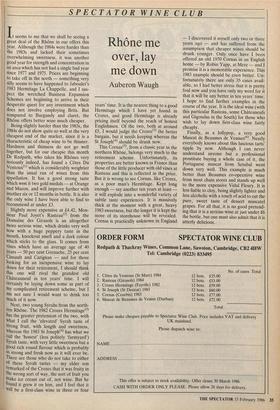SPECTATOR WINE CLUB
Rhone me over, lay me down
Auberon Waugh
Being slightly harder than the 1983s, the 1984s do not show quite so well at the very cheapest end of the market, since it is a characteristic of cheap wine to be thinner. Hardness and thinness do not go well together, but for our cheapie this month Dr Redpath, who takes his Rhones very seriously indeed, has found a Cotes Du Ventoux(1) which is considerably weightier than the usual run of wines from this appellation. It has a good strong taste Which won it two gold medals — at Orange and Macon, and will improve further with another six or 12 months in bottle. It is also the only wine I have been able to find to recommend at under £3.
Slightly more expensive at £4.42, Mon- sieur Paul Joyet's Rasteau(2) from the Domaine des Girasols is an altogether more serious wine, which drinks very well now with a huge peppery taste in the mouth, knockout smell and a dark colour Which sticks to the glass. It comes from vines which have an average age of 40 Years—SO per cent Grenache, 25 per cent Cinsault and Carignan — and for those looking for an inexpensive wine to lay down for their retirement, I should think this one will rival the grandest old Chateauneuf in ten years' time. I will certainly be laying down some as part of my complicated retirement scheme, but I am not sure I would want to drink too Much of it now.
Next, two young Syrahs from the north- ern Rhone. The 1982 Crozes Hermitage) has the greater pretension of the two, with What I call the 'elevated' Syrah taste of strong fruit, with length and sweetness, Whereas the 1983 St Joseph(4) has what we call the 'honest' (less politely 'farmyard') Syrah taste, with very little sweetness but a good rich round flavour which is probably as strong and fresh now as it will ever be. There are those who do not take to either of these Syrah tastes — my elder son remarked of the Crozes that it was fruity in the wrong sort of way, the sort of fruit you Make ice cream out of, not wine. But he found it grew it on him, and I feel that it Will be a first-class wine in three or four years' time. It is the nearest thing to a good Hermitage which I have yet found in Crozes, and good Hermitage is already pricing itself beyond the reach of honest Englishmen. Of the two, both at around £5, I would judge the Crozes(3) the better bargain, but it needs keeping whereas the St Joseph(4) should be drunk now. This Cornas(5), from a classic year in the northern Rhone, belongs very much to the retirement scheme. Unfortunately, its properties are better known in France than those of the little producer with old vines at Rasteau and this is reflected in the price. But it is wrong to see Comas, like Crozes, as a poor man's Hermitage. Kept long enough — say another ten years at least — it will explode into a wonderful variety of subtle taste experiences. It is massively thick at the moment with a great, heavy 1983 sweetness, but the longer it is kept the more of its storehouse will be revealed. Comas is practically unknown in England — I discovered it myself only two or three years ago — and has suffered from the assumption that cheaper wines should be drunk younger. Only once have I been offered an old 1970 Comas in an English home — by Robin Yapp, at Mere — and I promise it is a memorable experience. This 1983 example should be even better. Un- fortunately there are only 35 cases avail- able, so I had better stress that it is pretty foul now and you have only my word for it that it will be any better in ten years' time.
I hope to find further examples in the course of the year. It is the ideal wine (with this particular Rasteau, some Chateaneufs and Gigondas in the South) for those who wish to lay down first-class wine fairly cheaply.
Finally, as a lollypop, a very good Muscat de Beaumes de Venises(6). Nearly everybody knows about this luscious tarts' tipple by now. Although I can never understand anyone but a professional prostitute buying a whole case of it, the Portuguese muscat from Setubal went down very well. This example is much better than Beaumes co-operative wine from most chain stores and stands up well to the more expensive Vidal Fleury. It is less liable to cloy, being slightly lighter and less alcoholic with a touch of acid to cut the pure, sweet taste of dessert muscatel grapes. For all that, it is no good pretend- ing that it is a serious wine at just under £6 the bottle, but one must also admit that it is utterly delicious.





































 Previous page
Previous page